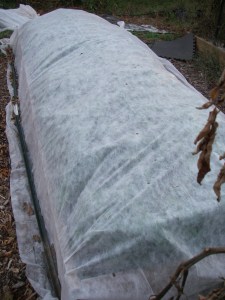Well the summer is definitely over and we are in the midst of excellent fall weather. I love the transitions between seasons…the tug-of-war between hot and cold…dry and wet. The plants, the birds, the mammals, and the insects all make adjustments and manage to survive.
An ambitious gardener can make some adjustments and have excellent crops into late fall and get a jump on things late winter. All you need is some well timed plantings and a a system for moderating temperatures and you can extend the use of your garden by 2 months on each end the traditional gardening times. Four months of extra growing times means four months of extra delicious harvests and gourmet meals to go with them.
The simplest thing to grow in the fall is a crop that really has to be planted in the fall…garlic. Early October is the time to get cloves in the ground for a late May/June harvest. Buy quality garlic bulbs from suppliers such as http://www.thegarlicstore.com/ I grow Elephant and Russian Red varieties and save about 1/3 of my harvest each summer to plant again in the fall.
The next easiest plants to grow have to be root crops such as turnips and beets. Toss these seeds in the ground, keep them damp for a few days and they provide amazing harvests of their roots and their delicious and nutritious greens.
Investing in a quality row cover such as Agribond 19 and row cover supports such as hoop loops is a bit more high tech than the other crops, but the rewards are worth the expense. I have the most beautiful lettuce, radish, kohlrabi, and cabbages growing under covers now. We’ve been eating salads for weeks and will be eating cabbage and kohlrabi well into November and maybe December.
If you’re fortunate enough to have a greenhouse, you can keep many plants alive and thriving with just a little supplemental heat. I brought in a bunch of my super hot peppers and some sweet peppers and have a milkhouse heater set to 38 degrees. It only kicks on when we have very cold nights…keeps the greenhouse just warm enough to keep the pepper plants alive. In the daytime the heater isn’t needed as the greenhouse traps a lot of heat and the peppers thrive.
Ok…now that you’ve got some good ideas for next fall, it is time to start thinking about early spring 2013! I will be offering an early gardening class in late February or early March depending on the weather next year. For $50 I will be providing instruction on how to plant a spring garden, Agribond and hoop loops to cover a 4 foot by 8 foot bed, and all of the lettuce, onion, beet, kohlrabi, and kale plants to fill the bed and some other seeds to complete the most awesome salad garden you have ever grown. I’ll have more details in January and will be taking sign-ups for the class then.












